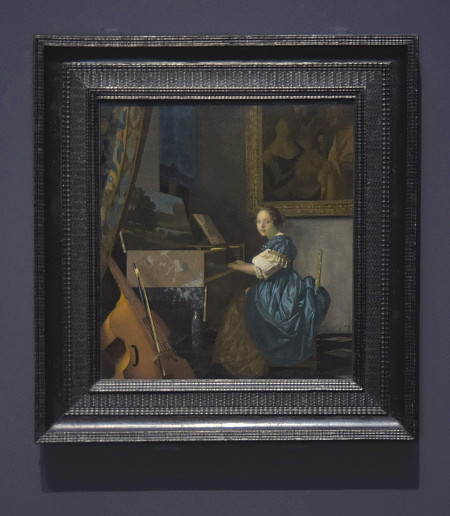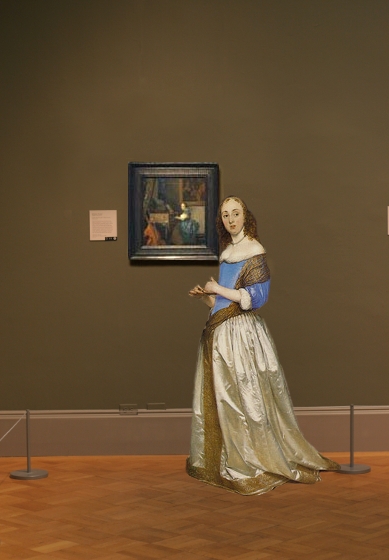A Lady Seated at a Virginal
(Zittende virginaalspeelster)c. 1670–1675
Oil on canvas, 51.5 x 45.5 cm. (20 1/4 x 17 7/8 in.)
National Gallery, London
inv. 2568

The textual material contained in the Essential Vermeer Interactive Catalogue would fill a hefty-sized book, and is enhanced by more than 1,000 corollary images. In order to use the catalogue most advantageously:
1. Scroll your mouse over the painting to a point of particular interest. Relative information and images will slide into the box located to the right of the painting. To fix and scroll the slide-in information, single click on area of interest. To release the slide-in information, single-click the "dismiss" buttton and continue exploring.
2. To access Special Topics and Fact Sheet information and accessory images, single-click any list item. To release slide-in information, click on any list item and continue exploring.
The curtain
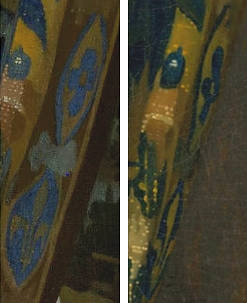
This section of drapery, a valuable hand-woven tapestry in actuality, bears a certain resemblance to those observed in Vermeer's Art of Painting. The curtain's detail in the Allegory of Faith, displaying two vertically aligned medallions—one adorned with a fleur-de-lys and another above it featuring a simple four-lobed floral motif—can be likened to the same feature in the present artwork. This suggests the possibility that the artist may have employed the same tapestry on multiple occasions.
Similar to Vermeer's other works, the curtain serves as a repoussoir device, an element strategically positioned in the immediate right-hand foreground to enhance the illusion of three-dimensional space.
While the curtain introduces a hint of sensuality within the composition's rectilinear structure, it falls short in creating a palpable sense of depth. The floral pattern imparts the impression of an isolated exercise in brushwork, disconnected from the form and substance of the weightless curtain. Even the inclusion of hallmark pointillés—spherical dots of light-colored paint intended to replicate the optical effect of the camera obscura—appear to be haphazardly scattered with limited conviction.
In fact, this painting is often considered one of the artist's final works, with some commentators discerning signs of artistic decline, likely influenced by economic and personal hardships stemming from the war with France. Vermeer passed away a few years after presumably rendering this piece, leaving his beloved wife Catharina to care for their 11 children amidst significant financial obligations.
The painting of the brothel on the background wall
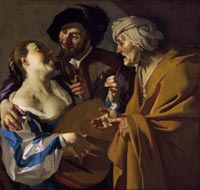
The Procuress
Dirck van Baburen
1622
Oil on canvas, 102 x 108 cm.
Museum of Fine Arts, Boston
This low-life brothel picture by Dirck van Baburen most likely belonged to Vermeer's mother-in-law, Maria Thins, who had patrician connections in Delft and a discreet art collection of the so-called Utrecht Caravaggists.
It portrays a young female lutenist, who is a prostitute, a bearded man, who is the client and an older woman, who is a procuress. The latter points to her opened hand, soliciting payment. Although these ribald low-life subjects had lost some of their appeal in the late 17th century, Vermeer seems to have appreciated Van Baburen's pictures not only as a way of introducing comments on the scenes represented in his own paintings but for their technical mastery as well. Van Baburen's Procuress has led some critics to interpret the seated musician's gaze as an invitation to profane love, but it is more likely that her virginal, often employed as a symbol of harmony, had associations with a more elevated form of love. Thus, the presence of the Van Baburen establishes a thematic contrast between the uncontrolled libido of the bordello scene and the virginal music associated with harmony and moderation.
Van Baburen's painting is now housed in the Boston Museum of Fine Arts and is the only object that materially links us to Vermeer's world other than his surviving 37 paintings. It also appeared in Vermeer's earlier Concert and seems to have a similar thematic function as in the present work, even though the golden Italianate frame has replaced the somber ebony one of the Concert version.
The role of the procuress in 17th-century brothels was pivotal. She played a crucial part in the operations of these establishments, particularly through the identification and recruitment of new sex workers. Often focusing on women from less privileged backgrounds who sought financial opportunities, the procuress was instrumental in bringing individuals willing to engage in the profession, negotiating terms such as payment, services and duration, all under her purview.
Additionally, some procuresses extended protection to sex workers. This entailed mediating disputes and establishing a secure environment to shield them from potential harm posed by clients. Managing financial matters, including compensation, was another facet of the procuress's role. She received a portion of the earnings as payment for her services.
An important aspect of the procuress's influence lay in her control over sex workers, both emotionally and financially. This dynamic often made it challenging for individuals to extricate themselves from the profession.
The simple blue curtain hidden in the shadow
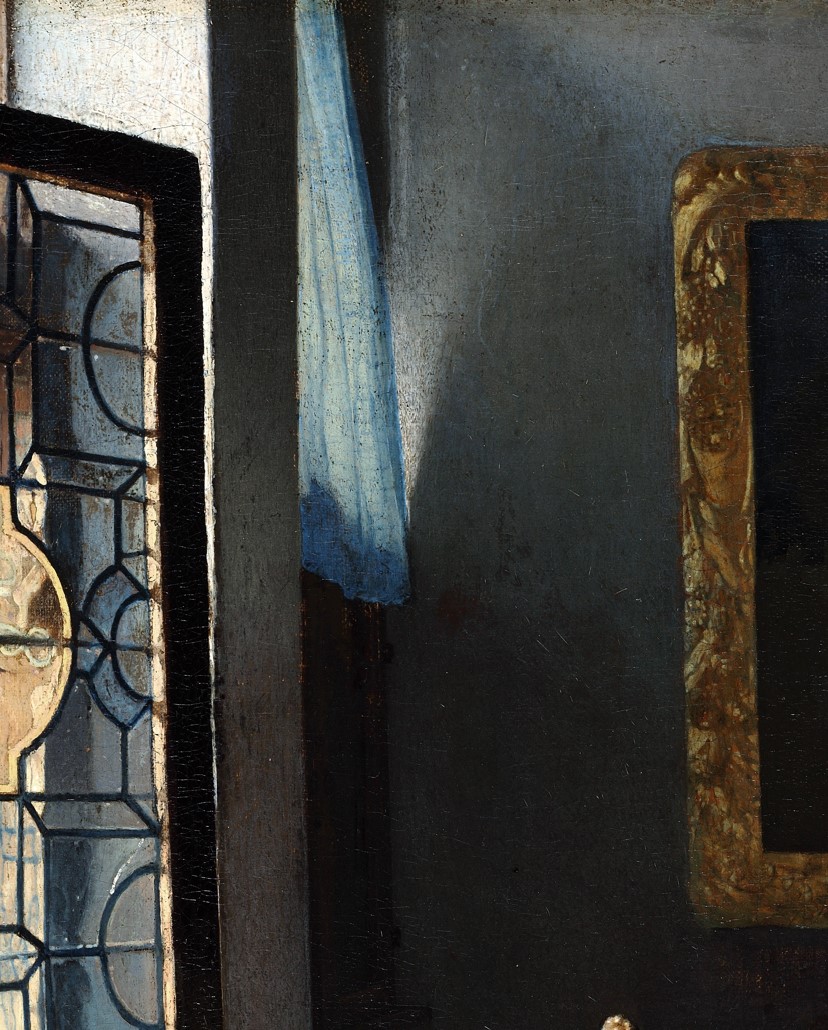
This blue curtain is presumably made of light, semi-transparent material. What might be taken for dark blue fringe along its lower border is created by the form of the window frame behind it. If this is true, either the light that filters through the upper part of the curtain is very weak or the rather summary rendering of the passage gives rise to the idea that it is one of the many passages that Vermeer did not bring to completion. A blue curtain appears in the artist's earlier The Glass of Wine.
To the left of the curtain, it is possible to make out a slight shift in tone on the lower part of the shadowed side wall which, in a recent examination of the picture, has been revealed to be a pentimento created by the dark picture frame which once hung on that part of the wall but was painted out by the painter.
The formal dress
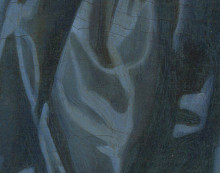
The young musician wears a formal silk multi-colored garment called a tabbaard, a combination of a stiffened gown and a matching bodice called a tabbaardslijft. These bodices were heavily boned, making them very uncomfortable and were thus worn only on formal occasions.
Even to the untrained eye, the mass of unruly folds of the blue gown appears to be painted quite crudely and can hardly compare with the delicately rendered silk gown in this work's counterpart, A Lady Standing at a Virginal.
Noting the lack of refinement of the gown's blue overskirt, some writers perceive a decline in Vermeer's artistic powers. However, since the same painting features various passages of exquisite painting technique, such as the leaning viola da gamba and the marbleized surface of the virginal, it was possibly left unfinished.
Characterized by several key features, the tabbaardslijft encompassed a structured and rigid form owing to its boned construction. The term tabbaardslijft itself conveys its composition, with "tabbaard" indicating the stiffened gown and "slijft" signifying the bodice. This distinctive attire was notably associated with formal occasions and special events, where its presence added an element of elegance and sophistication.
A typical tabbaardslijft ensemble consisted of multiple pieces, including a gown, overskirt, petticoat and accompanying accessories. These elements combined to create a refined and intricate appearance suited for ceremonies, celebrations and other significant gatherings.
The boning of the tabbaardslijft played a pivotal role in its construction. Utilizing materials such as whalebone, it lent a vertical and rigid structure that not only defined the upper body but also contributed to an improved posture. Despite its contribution to a polished silhouette, the tabbaardslijft was known for its discomfort due to its rigid nature. As a result, it was often reserved for formal events rather than everyday wear.
The lid of the virginal
The lids on the virginal of A Lady Seated at a Virginal and the Lady Standing at a Virginal both display pastoral landscapes which were frequently associated with the beauty of women or idyllic lovemaking. Although they appear quite normal as regards their perspective geometry, in truth they are most unusual.
When the landscape is reconstructed as if it were viewed frontally, it appears incorrectly stretched out. The architect Philip Steadman observed that such images appear to be related to those anamorphic landscapes that only look realistic when seen very obliquely. They are, in Steadman's opinion, like those puzzle pictures often concealing politically subversive or pornographic subjects, which became popular from the 17th century, such as the skull in Holbein's The Ambassadors, one of the best-known examples. The explanation for these anamorphoses might be that Vermeer traced the virginal or studied their images as would appear on the screen of a camera obscura and found them disturbingly foreshortened. He therefore decided to fill in the painted lid ignoring the steep perspective of the instrument. Indeed, viewers are generally undisturbed by this mild deception: before Steadman made his observation, no one had ever remarked on it.
The sheet music
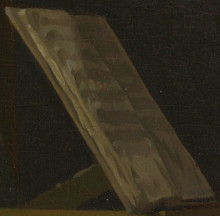
The sheet of music is so highly stylized that only a few notes can be made out. Analogous works by Vermeer's colleagues often show sheet music so meticulously rendered that the score can be read. It is not known if Vermeer was a practicing musician or even the level of his knowledge of music matters, but documents reveal that his grandfather was a musician and had owned more than one musical instrument.
During the 17th century in the Netherlands, sheet music held an important position within the musical landscape of the era. While printed sheet music did exist, handwritten musical manuscripts were more common. Musicians often created their own scores by hand, allowing for personalized adaptations suited to both performance and study.
Printed sheet music was available, but it was relatively expensive and not as widely accessible. Music publishing was a growing industry, and cities like Amsterdam and Antwerp emerged as key centers for publishing music. The sheet music of the time covered a diverse array of genres and styles, encompassing sacred and secular vocal pieces, instrumental compositions for various instruments, dances and works created for special occasions.
Dutch music publishers, such as Amsterdam's Estienne Roger, played a pivotal role in distributing printed music during this era. They published works by both Dutch and international composers, contributing to the cross-cultural exchange of musical ideas across Europe.
The viola da gamba
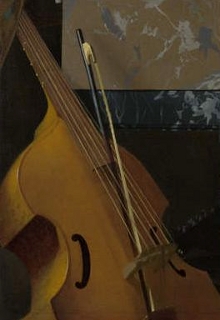
The viola da gamba, or viol, makes four minor but iconographically significant appearances in Vermeer's musical theme paintings: The Music Lesson, Woman with a Lute, The Concert and Lady Seated at a Virginal. Never once does he portray it being played. In all four paintings, it remains quietly unattended, perhaps meant to suggest the unseen presence of someone who will gather it up and make music.
Together with the lute, the viola da gamba is probably the most frequently represented instrument throughout the centuries, whether in painting, sculpture or miniature. Its deep resonance and unusual stature were typically associated with the male while the virginal with the female.
Here, the instrument has particular prominence, and from a technical point of view, it is a tour de force of observation and pictorial synthesis. Its complicated shape is particularly challenging to render correctly, especially when viewed from an oblique angle as is the case in the present work. Even though this painting fails to compete with other late works, it nonetheless contains some finely painted passages worthy of the artist's best works. For those familiar with the personal tragedy of Vermeer's final years when this work was being completed, it cannot help but resonate with pathos.
Who posed for the picture?
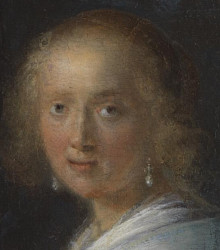
Woman at the Clavichord (detail)
Gerrit Dou
c. 1665
Oil on panel, 37.7 x 29.8 cm.
Dulwich Picture Gallery, London
Although none of the sitters of Vermeer's paintings have ever been identified, some seem to reappear, and art writers often suspect that they were members of the artist's family circle. Curiously, the seated musician in the present work bears a slight resemblance to the young musician in Gerrit Dou's composition of some years earlier, which no doubt provided Vermeer with the direct inspiration for the present work. Although Vermeer's girl smiles benignly toward the viewer, it is difficult to comprehend her thoughts and emotions. While her face is modeled with daring simplicity and extraordinary delicacy, the shape of her lips and eyes is so conventional that the resulting doll-like countenance may induce the observer to search elsewhere in the painting for deeper satisfaction.
The abstract painting of the virginal's side panel
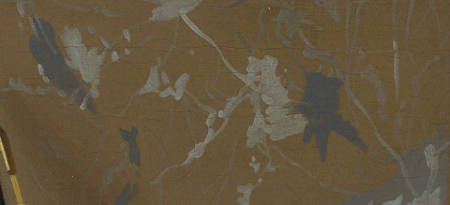
Even though Vermeer's late works have been judged negatively, they contain some of the most exquisite details that he painted. Vermeer critics have singled out the daring calligraphic brushwork used to portray the fake marbling of the virginal side panel, a feat of technical economy.
Vermeer first laid down two rectangles of unmodulated color, the upper a warm brown and the lower a gray below. Once dry, two or three mixtures of fluid gray were applied with quick, spontaneous brushwork to draw the marble's veins. The application of paint is so free that it recalls the almost anarchic spontaneity of Jakuchu's ink drawings of birds and vegetables, but at the same time, it evokes the visual impression of veined marble. One author has compared the effect to Jackson Pollock's drip paintings.
The art of creating faux marble, also known as "marbling," involved painting or staining surfaces to imitate the appearance of real marble. This technique allowed craftsmen to replicate the intricate veining and color variations found in natural stone. While actual marble was costly and heavy, faux marble provided an elegant and lightweight alternative for adorning various objects, including musical instruments.
Faux marble panels were a common decorative feature on 17th-century virginals and other keyboard instruments. These instruments were not only tools for producing music but also symbols of status and refinement in the households of the affluent. Faux marble panels were used to enhance the visual appeal of these instruments, creating an impression of luxury and sophistication
The puffy sleeve: a daring piece of painting technique
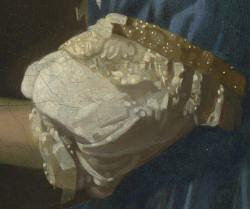
The puffy linen sleeve of the young musician's elegant attire stands out as one of the most remarkable passages in the present work. Although the tuck and fold of the candid white fabric lack precise definition, its tactile quality has been described by some writers as suggested rather than explicitly detailed. The brushwork, bold yet skillfully controlled, could be likened to the work of the finest abstract painters of the 20th century. The white paint employed, the ubiquitous lead white, is applied fluidly using a pointed brush. During Vermeer's era, the Dutch were celebrated producers of lead white, which remained the sole stable white pigment available for oil painters.
Artificially prepared since ancient times and utilized until the 19th century, lead white possesses warmth and semi-opacity. Its exceptional brushing characteristics make it compatible with every color on the artist's palette. As its name implies, lead white is derived from lead and its purity is contingent upon the purity of the lead used, with purification processes significantly elevating its production cost.
Lead white has consistently held a prominent role in numerous painting techniques. In the 1620s, the Dutch significantly enhanced the availability of lead white while reducing costs through the development of the "stack process," an approach documented in ancient sources by figures such as Theophrastus, Pliny the Elder and Vitruvius.
In the Dutch stack process, lead strips were rolled into spirals and placed within sealed earthenware jars containing acetic acid. These containers were then buried beneath layers of tanner's bark or dung; the heat generated by fermentation facilitated the formation of white lead by increasing carbonic acid levels. This led to the development of a thin layer of basic lead carbonate. This resultant product was scraped off, dried and washed to eliminate any impurities.
Commonly, this lead corrosion product on the plates took on the appearance of thick, curling crusts or scalloped flakes, leading to the term "schulp white" or "flake white," which was esteemed as the highest quality available. A less expensive mixture of lead white extended with chalk, widely used in Dutch industry, was referred to as "lootwit." Lootwit served for less demanding applications, such as grounds, and was also used for underpainting or layers requiring translucency. The addition of chalk to lead white reduced its opacity when utilized in oil painting. It is crucial to handle lead white with care due to its extreme toxicity.
The girl's "not-so lovely" arms
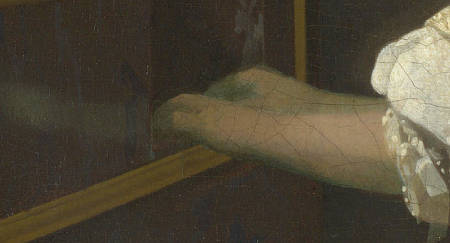
The young girl's arms have been noted by various writers. Some perceive evidence of technical decline. For instance, art historian Albert Blankert unceremoniously labeled them "pig trotters." Others, however, observe one of the distinctive hallmarks of Vermeer's artistic approach, referred to as the "optic way," a term coined by Vermeer scholar Lawrence Gowing.
Gowing proposed that the foundation of the artist's mature style rested on his dedication to optical accuracy, possibly influenced by the utilization of the camera obscura—an early version of the modern photographic camera. According to Gowing, Vermeer's mode of depiction "is always exactly adequate, always completely and effortlessly in terms of light. Vermeer seems almost not to care, or not even to know, what it is that he is painting. What do men call this wedge of light? A nose? A finger? What do we know of its shape? To Vermeer none of this matters, the conceptual world of names and knowledge is forgotten, nothing concerns him but what is visible, the tone, the wedge of light."
Similarly, Kenneth Clark was puzzled by Vermeer's "uncannily true sense of tone," which he employed with an "almost inhuman detachment." It is this fidelity to tonality—not meticulous attention to minutiae—that imparts a "photographic" quality to the paintings that has captivated photographers since the mid-19th century and filmmakers in the 20th century.
The big gilt frame

Vermeer scholars have provided various explanations for the unconventional treatment of the large, Italianate frame adorning The Procuress by Dirck van Baburen. Vermeer's depiction falls short in capturing the gleam or hue of a gilded frame. The intricacies of its elaborate carvings have been so drastically abstracted that the underlying motif remains indecipherable. Although intriguing, the fragments of ochre paint seem to evoke the "dots" and "dashes" of Morse code rather than a finely carved frame.
Some writers choose not to critique the handling of the object as flawed or incomplete, interpreting it instead as an intentional stylistic choice. However, even if Vermeer deliberately abstracted forms to an unexpected degree in his final works, the masterfully executed frames in The Guitar Player and the likely pendant to the current piece (Lady Standing at a Virginal) cast doubt on whether the frame in question aligns with Vermeer's initial intentions.
While it is accurate that upon close examination, the frames of The Guitar Player and the Lady Standing at a Virginal exhibit a comparable shorthand of flecks and dabs of thick and thin paint, their visual and material qualities are elevated rather than obscured. These frames seem to evoke the sensation of a lustrous gilded frame more effectively than any amount of precision or descriptive detail could. In contrast, the frame of the Lady Seated at a Virginal conveys an almost peculiar lifelessness.
Nonetheless, the questionable quality of the frame can be readily explained by the incomplete state of the painting. Various sections within this work display technical shortcomings, such as the muddied yellowish gown and greenish-blue silk overskirt. Both areas appear to be roughly blocked in with minimal attention to detail. Conversely, other areas—like the viola da gamba are drastically abstracted yet astonishingly successful in conveying form, color, texture and the play of natural light. The disparity between the meticulously finished portions and the crudeness of others leaves no uncertainty that the painting is either unfinished or not optimally conserved.
The big gilt frame

Vermeer scholars have provided various explanations for the unconventional treatment of the large, Italianate frame adorning The Procuress by Dirck van Baburen. Vermeer's depiction falls short in capturing the gleam or hue of a gilded frame. The intricacies of its elaborate carvings have been so drastically abstracted that the underlying motif remains indecipherable. Although intriguing, the fragments of ochre paint seem to evoke the "dots" and "dashes" of Morse code rather than a finely carved frame.
Some writers choose not to critique the handling of the object as flawed or incomplete, interpreting it instead as an intentional stylistic choice. However, even if Vermeer deliberately abstracted forms to an unexpected degree in his final works, the masterfully executed frames in The Guitar Player and the likely pendant to the current piece (Lady Standing at a Virginal) cast doubt on whether the frame in question aligns with Vermeer's initial intentions.
While it is accurate that upon close examination, the frames of The Guitar Player and the Lady Standing at a Virginal exhibit a comparable shorthand of flecks and dabs of thick and thin paint, their visual and material qualities are elevated rather than obscured. These frames seem to evoke the sensation of a lustrous gilded frame more effectively than any amount of precision or descriptive detail could. In contrast, the frame of the Lady Seated at a Virginal conveys an almost peculiar lifelessness.
Nonetheless, the questionable quality of the frame can be readily explained by the incomplete state of the painting. Various sections within this work display technical shortcomings, such as the muddied yellowish gown and greenish-blue silk overskirt. Both areas appear to be roughly blocked in with minimal attention to detail. Conversely, other areas—like the viola da gamba are drastically abstracted yet astonishingly successful in conveying form, color, texture and the play of natural light. The disparity between the meticulously finished portions and the crudeness of others leaves no uncertainty that the painting is either unfinished or not optimally conserved.
The yellow skirt
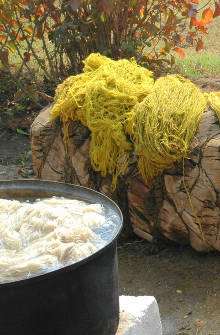
Wool dyed with reseda at Wissa Wassef Art Centre, Giza, Egypt
Among all those of Vermeer's ouevre, the yellowish skirt stands as one of the less appealing passages, notable for its peculiar calligraphic modeling of the folds and its muted yellow-brown hue. A recent technical analysis of a sample extracted from the skirt suggests the presence of a yellow lake pigment. Lake pigments are created by precipitating a dye with an inert binder to provide substance for painting. In contrast to pigments like vermilion and ultramarine derived from ground minerals, lake pigments originate from organic materials. These pigments are inherently transparent and were extensively used by artists as glazes—thin layers of transparent paint applied over an opaque layer to modify color or depth without altering tonal values. Similar to many Dutch painters of the 17th century, Vermeer employed lake pigments to enrich shadowed areas and enhance the vibrancy of dull or dark colors, despite their light sensitivity and propensity to fade over time.
The weld plant was a common source of yellow lake paint, possessing a high content of luteolin, a flavonoid that yields a vivid yellow dye. Weld dye, still employed in certain regions, is compatible with linen, wool and silk. Nevertheless, the coloring component could also be acquired from dyed cloth remnants or other discarded textiles, rather than solely from raw materials.
The paint cross-section extracted from the skirt exposes particles of bone black, red earth and yellow pigments. Contemporary conservators contend that the unappealing yellow tone largely results from overpaint and discolored varnish. The inclusion of a small amount of bone black along with the yellow lake would have initially produced a slightly greenish-yellow underskirt color. This hue, according to conservators, would have harmonized well with the blue-green overskirt.
A missing frame
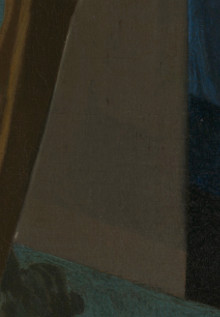
In a recent examination of the painting, an infrared reflectogram unveiled a mirror or frame suspended on the wall above the virginal's lid, which Vermeer subsequently covered with paint. This alteration, termed pentimenti, is scarcely detectable, marked only by a discernible diagonal strip of slightly darker gray, generally not detectable in photographic images. A pentimento (plural: pentimenti) is an alteration or revision made by an artist during the process of creating a painting, drawing or other works of art. The term comes from the Italian word "pentirsi," which means "to repent" or "to regret." Pentimenti are often visible traces of changes that the artist made as they rethought elements of the composition, such as the position of objects, the arrangement of figures or the overall design.
The proliferation of pentimenti in Vermeer's works, particularly evident through the application of advanced scientific laboratory tools, highlights how meticulous he was in considering the formal balance and meanings of his compositions compared to other Dutch genre painters of his time. Detected alterations, such as shifting a map slightly to the left or repositioning objects within a painting, demonstrates Vermeer's unique sensitivity to compositional design. This sensitivity emerged long before the concept of planimetric organization became a significant concern for artists, as seen in the 20th century.
A recent discovery, for instance, revealed that the left-hand wall in The Love Letter extended to the standing maid's left arm. The prominently featured clothes basket and the blue pillow on the tiled floor were later additions to an already completed scene. Notably, a handful of Vermeer's paintings exhibit minimal signs of revision, with The Art of Painting being an example. However, other works, such as Girl Reading a Letter at an Open Window, underwent significant reworking.
While some pentimenti may relate solely to compositional considerations, some art historians suggest that Vermeer's revisions were driven by his desire to reshape or further clarify the symbolic meanings of his compositions. This could involve the inclusion or exclusion of certain objects, thereby enhancing the depth and significance of his art beyond its pure visuality.
A "nondescript" background wall
Despite their apparent ordinariness, the background walls in Vermeer's interiors play a pivotal role in determining the intensity of incoming light and the prevailing atmosphere of the depicted scene. However, creating the illusion of light raking across the surface of a flat plaster wall with paint presents a significant technical challenge, and a few of Vermeer's walls, such as those in The Milkmaid or The Music Lesson, stand as some of the most evocative passages in all of Dutch painting. It's as if Vermeer's contemporaries considered these walls mere placeholders, relying on simple formulas for their execution, while Vermeer grounded his interpretations in keen observation.
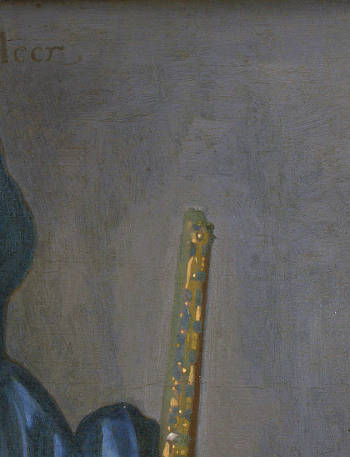
In essence, to achieve the illusion of raking light, the painter must not only vary the tonal values (brightness level from white to black, akin to a black and white photograph) but also the hues (actual color) of their paint. In works representing strong light streaming through a side window, the portions of the wall nearer to the light source appear lighter and cooler (slightly bluish), while those farther away grow proportionately darker and warmer (neutral gray). The deepest shadows must be depicted with relatively warm grays.
In the current painting, the visible side window remains tightly shut, resulting in a dim background. It is reasonable to assume that the light shining on the viola da gamba and the figure enters an unseen second window closer to the viewpoint of the painter and, consequently, the viewer. While the light that illuminates the foreground objects is fairly intense, it diminishes significantly by the time it reaches the background wall—Vermeer seems to communicate this message. In any case, the lighting of the picture lacks coherence, and the overall impression is one of weary dullness, rather than the illusion of the play of light as it rakes across the uneven surface of a white-washed wall. Instead of the wall, the collection of subdued medium-dark grays fall short of creating the illusion, and this passage appears no more than a loosely applied layer of nondescript, drab gray paint.
However, the deficiency of the background wall could be attributed to the painting's unfinished state, a proposition voiced by multiple experts. Indeed, upon close examination, it becomes evident that the brushstrokes deeply embedded in the paint of the wall to the right of the figure are unusually large and rapidly applied—techniques that contrast with the delicate brushwork of the completed areas, such as the viola da gamba and virginal. These areas exhibit intricate detailing and fresh coloring. It's possible that the artist initially roughed in the background portions during an early phase of the painting process to assist in evaluating the tonal and color relationships of the remaining parts. Unlike contemporary painters who often build up their compositions gradually, artists in Vermeer's time often developed them piecemeal, completing each section within clearly defined boundaries.
special topics
The signature

Inscribed at left below the upper edge of the virginal: IVMeer (IVM in ligature).
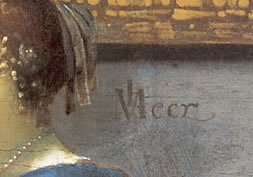
(Click here to access a complete study of Vermeer's signatures.)
Dates
1674–1675
Albert Blankert, Vermeer: 1632–1675, 1975
c. 1675
Arthur K. Wheelock Jr., (The Public and the Private in the Age of Vermeer, London, 2000
c. 1670–1672
Walter Liedtke, Vermeer: The Complete Paintings, New York, 2008
c. 1672–1674
Wayne Franits, Vermeer, 2015
(Click here to access a complete study of the dates of Vermeer's paintings).
Technical report
The fine, plain-weave linen support boasts a thread count of 14 x 14 per cm². The original tacking edges have been removed. Cusping is observable along the top and bottom, and very faintly along both sides. The support has undergone lining. The double ground consists of a pale gray layer beneath a warm gray buff layer. The initial layer incorporates lead white, chalk and charcoal black; the subsequent layer comprises lead white, chalk and a red-brown earth pigment.
The flesh color was applied using green earth over a pink underlayer; the shadows were developed through two additional layers—a blend featuring green earth followed by a deep red shadow layer. The blue upholstery was initially underpainted with a gray-blue layer; highlights were modeled using a blue layer followed by a pale blue layer, while shadows were rendered with gray. The outlines of the tiles at the bottom of the wall were incised into the wet paint. A pinhole, utilized by Vermeer as a marker for the vanishing point, is discernible in the paint layer on the woman's dress sleeve.
Some abrasion is evident in the three paintings within the painting, the lady's right cheek, the dark blue of her tunic and the blue upholstery. The ultramarine pigment in the darker blues of the chair has deteriorated.
* Johannes Vermeer (exh. cat., National Gallery of Art and Royal Cabinet of Paintings Mauritshuis - Washington and The Hague, 1995, edited by Arthur K. Wheelock Jr.)
Provenance
- (?) Diego Duarte, Antwerp (1682, sold before 1691), or (?) Dissius sale, Amsterdam, 16 May, 1696, no. 37, or (?) Nicolaes van Assendelft, Delft (before 1692) and widow Van Assendelft, Delft (1711);
- (?) sale, Amsterdam, 1714, possibly no. 12;
- Lothar Franz von Schönborn, Schloß Weissenstein, Pommersfelden (c. 1714–1729);
- Count von Schönborn sale, Paris, 17ff. May 1867, no. 78 (to Thoré-Bürger);
- Thoré-Bürger (Etienne Joseph Théophile Thoré), Paris (1867–d.1869);
- Paul Lacroix, Paris (1869–1884, inherited from Thoré-Bürger);
- widow Lacroix, Paris (1884–1892);
- Thoré-Bürger sale, Paris, 5 December, 1892, no. 32 (to Sedelmeyer);
- [Sedelmeyer, Paris, 1892–1893];
- [Lawrie & Co., London, 1893, from Sedelmeyer];
- [T. Humphry Ward, London, 1894];
- George Salting, London (before 1898-d.1910);
- The National Gallery, London, Salting Bequest, 1910 (inv. 2568).
Exhibitions
- London 1894
Exhibition of Works by Old Masters and by Deceased Masters of British School
Royal Academy of Arts
22, no. 93, as "A Lady at a Spinet," lent by T. Humphry Ward, Esq. - Paris 1898
Illustrated catalogue of 300 Paintings by Old Masters of Dutch, Flemish, French, and English School Being Some of the Principal Pictures Which Have at Various Times Formed Part of Sedelmeyer Gallery
Sedelmeyer Gallery
102, no. 85 and ill., as "A Lady at a Spinet" - London 1900
Exhibition of Pictures by Dutch Masters of Seventeenth Century
Burlington Fine Arts Club
24, no. 15 as "A Lady Playing the Clavichord," lent by George Salting, Esq. - London 1907
Catalogue of a Collection of Pictures, Decorative Furniture and Other Works of Art (Winter Exhibition)
Burlington Fine Arts Club
4, no. 13, lent by Otto Beit - London 1976
Art in Seventeenth-Century Holland
The National Gallery
93, no. 117 and ill. - Modena, Italy 15 April–15 July, 2006
Vermeer: La ragazza alla spinetta e i pittori di Delft
Galleria Estense
134–135, no. 18. - Washington D.C. November 12, 1995–February. 11, 1996
Johannes Vermeer
National Gallery of Art
200–203 and ill. - The Hague March 1–June 2, 1996
Johannes Vermeer
Mauritshuis
200–203, no. 22 and ill. - New York March 8–May 27, 2001
Vermeer and the Delft School
Metropolitan Museum of Art
no. 79 - London June 20–September 16, 2001
Vermeer and the Delft School
National Gallery
no. 79 - Modena (Italy) April 15–July 15, 2006
Vermeer: La ragazza alla spinetta e i pittori di Delft
Galleria Estense
134–135, no. 18 and ill. - Cambridge October 5, 2011–January 21, 2012
Vermeer's Women: Secrets and Silence
Fitzwilliam Museum
206, no. 27 and ill. - London June 26–September 8, 2013
Vermeer and Music: Love and Leisure in the Dutch Golden Age
National Gallery
66, no. 23 and ill. - Paris February 22–May 22, 2017
Vermeer and the Masters of Genre Painting: Inspiration and Rivalry
Musée du Louvre - Tokyo June 18–October 18, 2020
Masterpieces from the National Gallery
National Museum of Western Art, Tokyo - Osaka November 3, 2020–January 31, 2021
Masterpieces from the National Gallery
National Museum of Art, Osaka - Amsterdam February 10– June 4, 2023
VERMEER
Rijksmuseum
no. 34 and ill.
(Click here to access a complete, sortable list of the exhibitions of Vermeer's paintings).
The 17th-century virginal
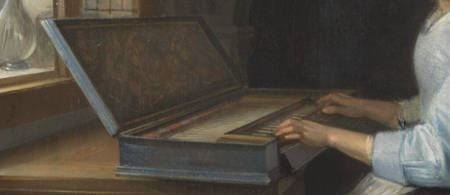
Woman at the Clavichord (detail)
Gerrit Dou
c. 1665
Oil on panel, 37.7 x 29.8 cm.
Dulwich Picture Gallery, London
In 17th-century Netherlands, both the virginal (also called virginals) and the clavichord were referred to as clavecijn, clavesingel or clavecimbael, which understandably leads to confusion. The virginal depicted in Vermeer's painting belongs to the "muselar" type. Due to the elevated keyboard, it was not uncommon to play the instrument while standing; however, the seated lady's posture is not ergonomically optimal, as her visible elbows are positioned lower than her hands.
The etymology of the word "virginal" is unclear, but it is commonly associated with the instrument's historical association with young women. During the late 16th and early 17th centuries, muselar virginals gained popularity for their distinctive sound quality. They were cheifly crafted in Northern Europe.
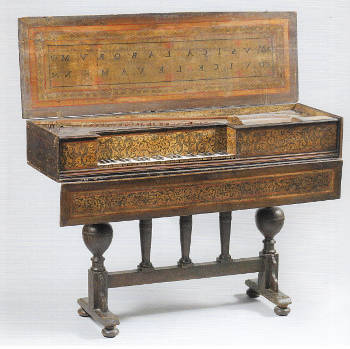
Virginals (detail)
Andrea Ruyckers I
1646, Antwerp
Wood and paperl, 150 x 29 x 43 c.
Rijksmuseum, Amsterdam
The placement of the keyboard on the right side enables the playing mechanism to produce a rich and resonant sound by plucking the strings at their midpoint, but it also positions the action for the left hand in the precise center of the highly resonating soundboard. This occasionally results in unavoidable clicks, which are faithfully amplified by the soundboard and can make rapid left-hand scales somewhat challenging. Alongside mechanical noises, the central plucking point for the bass notes complicates rapid repetition. This is because the movement of the still-vibrating string interferes with the plectrum's ability to strike the string again. An 18th-century observation, which reflects some bias, goes as far as to assert that instruments which have the keyboard on the right-hand side are good in the right hand, but "grunt in the bass like young pigs."
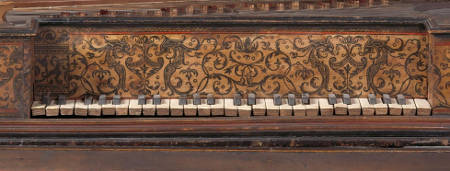
Certain virginals were affixed to a self-standing box, as depicted in the present work. Other Dutch genre painters portrayed the box-like version, which was positioned on a table.
The Delft baseboard tiles
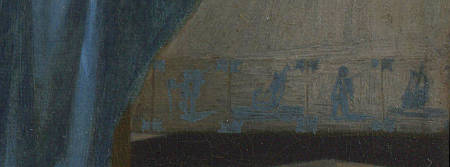
The ornamental patterns on the tiles within this composition are challenging to discern due to the significant lightening of the dark blue paint Vermeer employed to depict them. This paint, derived from crushed lapis lazuli imported from Afghanistan, has noticeably faded, particularly evident under the virginal. Nonetheless, there seem to be two ships and two standing figures within the design, possibly representing the fishing Cupid depicted in other works by Vermeer. This phenomenon, commonly observed in paintings of the era, is referred to as ultramarine sickness. Current understanding suggests that this fading results from the deterioration of the binding medium rather than the blue pigment itself.
Delft baseboard tiles, created in 17th-century Delft, Netherlands, were ceramic pieces distinguished by their iconic blue and white designs. Crafted through tin-glazing, a process involving a white tin oxide-based glaze and cobalt blue pigments, these tiles served both aesthetic and functional purposes in Dutch interiors. Acting as protective skirting elements, they guarded walls from moisture and damage in areas prone to spills, such as kitchens and corridors. Beyond their practical role, these tiles added elegance to spaces while also being accessible to a wide range of households. Their production was centered in Delft and extended to other towns, resulting in a broad distribution within the Netherlands and beyond. The popularity of Dutch decorative arts led to their export across Europe, and even to the Oreint. in significant quantities, where they found widespread use. These tiles served a dual purpose during their journey to the East. They were not only highly valued commodities for trade but also practical ballast for Dutch ships. This practice of using the tiles as ballast ensured stability and balance for the vessels during their long voyages to distant destinations.
Playing music
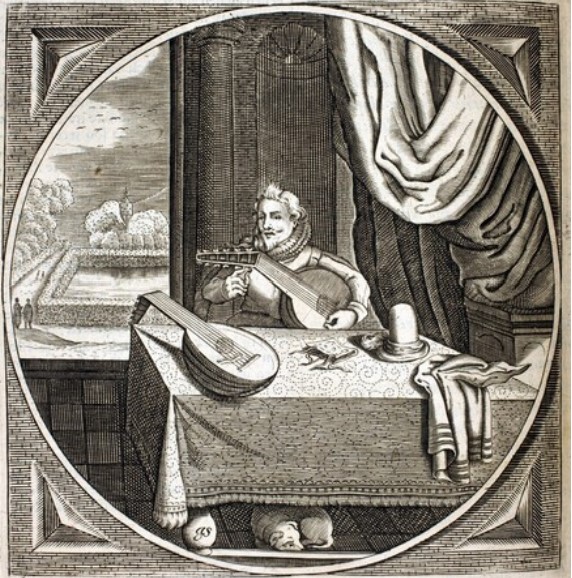
Proteus, ofte, Minne-beelden verandert in sinne-beelden "Quid Non Sentit Amor"
Jacob Cats
1627
National Gallery of Art Library, Washington D.C.
Female keyboard players were a popular subject in 17th-century Dutch art. Music making was often associated with love and at times with amorous seduction. In verses by Jacob Westerbaen we read: "learn to play the lute, the clavichord. The strings have the power to caress the heart." The virginal, however, had civilized connotations as well because it was habitually played by a woman in the context of family or musical gatherings, thus, being used most often by artists as a symbol of harmony and concord.
The unattended viola da gamba in the foreground further strengthens the association with harmony. The woman, like the male musician in Jacob Cats' well-known emblem "Quid Non Sentit Amor", plays her instrument while a second one lies unused. The emblem's text explains that the resonance of one lute echoes onto the other just as two hearts can resonate in harmony even if they are separated.
Vermeer & Gerrit Dou
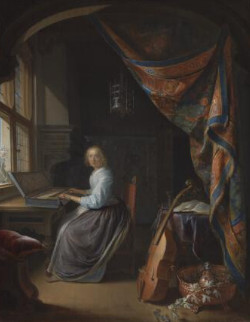
Woman at the Clavichord
Gerrit Dou
c. 1665
Oil on panel, 37.7 x 29.8 cm.
Dulwich Picture Gallery, London
The remarkable similarity between this painting and Gerrit Dou's Woman at the Clavichord (c. 1665) demonstrates that Vermeer derived his composition from the work of the Leiden fijnschilder (fine painter), who was one of the most sought after and highly paid artists of the time. The pose, the pulled-back curtain, the viola da gamba and even the girls' faces have a great deal in common.
Artistic borrowing of successful motifs was quite common among Dutch painters who were always strained to produce enough works for the voracious art market. In the 17th century, intellectual property was an unknown concept and everyone could draw on the storerooms of a common stock. However, the difference in execution between the two paintings can be easily discerned even at first glance. Dou spared no pain to render each and every detail with the utmost fidelity while Vermeer applies paint broadly. This technique suggests, rather than describes, form, texture and light. Vermeer improved on Dou's composition by moving the viewpoint closer to the subject, drawing the observer into closer contact with the girl who has just turned her head away from her music toward the spectator.
Bought by a banker
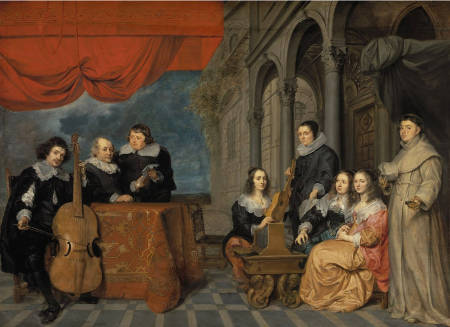
Portrait of a Family, probably of Jacob Dissius
Gonzales Coques
c. 1653
Oil on canvas, 65.5 x 89.5 cm.
Museum of Fine Arts, Budapest
Although genre painters typically operated in the open market, they remained open to collaborating with elite patrons who sometimes generously compensated the most renowned artists. The present work could potentially exemplify such a practice. Notably, some experts have observed the influence of Diego Duarte on Vermeer's choice of subject.
Diego Duarte, an immensely affluent Portuguese jeweler, banker, composer, organist and art collector from Antwerp, maintained a connection with Constantijn Huygens, who resided in The Hague, much like the sculptor Johan Larson. Larson possessed a tronie by Vermeer, presumably acquired during a trip to Delft in 1660.
However, Duarte's association with the painting might be attributed as much to artistic affinity as to friendship. Duarte's father commissioned a clavecin for Huygens, and Duarte engaged in musical correspondence with Huygens. He was also an accomplished organist and composer. Thus, it is fitting that Duarte's inventory includes Vermeer's work under number 182, described as "a small painting with a lady playing the clavecin, with accessories."
The valuation of Vermeer's painting was 150 guilders, a modest sum compared to the time when Gerrit Dou could command ten times that amount for a painting of similar size.

Jan Pietersz. Sweelinck
Jan Harmensz. Muller
1624
Engraving, 23.81 x 15.4 cm
Los Angeles County Museum of Art, Los Angeles
While Dutch music was generally perceived as conventional, a few musicians like Jan Pieterszoon Sweelinck produced noteworthy compositions. Sweelinck's works for the flute, virginal and organ are well-regarded. It is tempting to envision the young girl in the painting playing one of Sweelinck's charming pieces, such as Malle Symen or Silly Simon, a popular hit of the era.
Part of a pendant?

Vermeer scholars have grappled with the question of whether this painting was intended as a pendant to the Lady Standing at a Virginal. The two artworks are nearly identical in size, both depicting elegantly attired young women playing virginals in refined surroundings. When placed side by side, the virginals would be positioned back to back, with the light and airy ambiance of one serving as a complement to the darker tone of the other. This interplay of complementary qualities is a hallmark of Dutch pendants, and Dutch painters often seized the opportunity to astutely explore the underlying psychological and aesthetic distinctions between similar subjects. Notably, the background paintings appear to further reinforce the harmonious pairing. The standing woman is accompanied by an image of a standing Cupid, likely sourced from a popular emblem book of the era. This emblem encourages fidelity in love. Conversely, the seated woman, positioned against a scene of ordinary life, may hint at illicit romantic encounters. And according to the art historian Bart Cornelis, "the question was more or less settled once it was established that the canvas supports of both pictures are in fact cut from the same bolt of cloth. This strongly supports the conclusion that Vermeer conceived of these two works as pendants. It is therefore all the more satisfying that they came to be united in one public collection."
The theme of Sacred and Profane Love likely resonated with educated 17th-century Dutch viewers, trained to discern moral allegory cleverly veiled within seemingly casual depictions of daily existence. However, the two works differ significantly in technique, prompting some critics to date the seated lady's creation four years later than her presumed counterpart. While we cannot dismiss the possibility that they are simply variations on a common theme, destiny has united them once again after over three centuries in the National Gallery of London.
Diego Duarte, an immensely wealthy Antwerp jeweler, banker & art lover
Diego Duarte, an immensely wealthy jeweler and banker from Antwerp, could have potentially acquired this painting directly from Vermeer. We are aware of Duarte's ongoing connections to the Netherlands, facilitated through Constantijn Huygens, who resided in The Hague alongside the sculptor Johan Larson. Larson is known to have owned a tronie by Vermeer, likely purchased during a trip to Delft in 1660.
Nevertheless, Duarte's association with the artwork might be attributed as much to shared artistic sensibilities as to personal friendship. Duarte's father commissioned a clavecin for Huygens, and their correspondence included discussions on music. Duarte himself was a skilled organist and composer. Given his musical inclinations, it is fitting that Duarte's Vermeer, cataloged as inventory number 182, is described as "a small painting with a lady playing the clavecin, with accessories."
The painting was appraised at 150 guilders, a considerable but not extraordinary sum for that period. This valuation occurred at a time when Gerrit Dou commanded tenfold that amount for paintings of similar dimensions.
Listen to period music
dfdf![]() Almande De Symmerman [236 KB] very likely Almande The Carpenter (anon.) from The Susanne van Soldt Manuscript (1599)
Almande De Symmerman [236 KB] very likely Almande The Carpenter (anon.) from The Susanne van Soldt Manuscript (1599)
![]() Malle Symen [236 KB] "Silly Simon"
Malle Symen [236 KB] "Silly Simon"
(Jan Pzn. Sweelinck) from The Leningrad Manuscript (1646)
![]() Courante Daphne [236 KB] The popular melody Daphne as a French "Courante" dance (anon.) also from The Leningrad Manuscript (1646)
Courante Daphne [236 KB] The popular melody Daphne as a French "Courante" dance (anon.) also from The Leningrad Manuscript (1646)
* all three music files were kindly selected and performed for the Essential Vermeer website by Joop Klaassen, contributor to the Stichting Clavecimbel Genootschap Nederland.
The virginal is a kind of harpsichord. Mr Klaassen's muselar virginals were built by Louis van Emmerik, after the Ruckers virginals of 1611 in "Het Vleeshuis," a museum in Antwerp, Belgium. The muselar virginals have the keyboard on the right, and they have a richer sound than the spinet virginals, which have the keyboard on the left. The virginals in Vermeer's paintings are of the muselar type.
For more information on Vermeer and the virginal, click here.
![]() Solfaing Song à 5 [3.45 MB]
Solfaing Song à 5 [3.45 MB]
by Thomas Tallis
from: Ancient Instruments – Tuxedo (various artists)
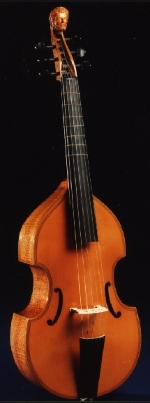
The Viola da Gamba
The viol, also known as the viola da gamba, traces its early origins to medieval waisted fiddles and rebecs that were played similarly to viols: held downward on the lap or between the knees, with the bow positioned above the palm.
Evidence from Renaissance iconography suggests that the viol emerged by adapting the traditional Aragonese rebec-playing technique to a novel bowed instrument, akin in size and construction to the vihuela de mano (a plucked instrument akin to the guitar). Thus, the term "vihuela de arco" seems fitting for this new instrument.
This bowed innovation rapidly spread from Spain to Italy. Italian craftsmen, renowned for their exceptional skill, transformed the vihuela into the viol form. The "viole grande" found enduring favor in the European courts.
In the 17th century, Sainte-Colombe was a standout figure in viol playing, introducing silver-covered strings and an additional seventh low string. His pupil, Marin Marais, not only surpassed his master's skill but elevated the viol to its pinnacle of excellence through virtuoso performances and exceptional compositions.
Viols existed in various sizes including "pardessus," treble, alto, small tenor, tenor, bass and violone (contrabass), yet the treble, tenor and bass viols typically constituted a standard consort.
Characterized by downward-sloping shoulders, a narrow upper body, deep ribs, middle bouts, a gently arched belly and a flat back, the viol's distinct shape became standardized during the 17th and 18th centuries. It typically features six strings, although the solo bass viol played on the Continent during the Baroque era often incorporated seven strings (an innovation attributed to Sainte-Colombe).
The gut frets, affixed around the neck in a specialized fret knot, usually number seven and are spaced at semitone intervals.
Early viol bows exhibit a convex form and are grasped from beneath, allowing the player to regulate bow pressure on the strings with precision.
Marin Mersenne, a musicologist, once lauded the viol as an instrument that most faithfully imitated the human voice.
Vermeer's tombstone
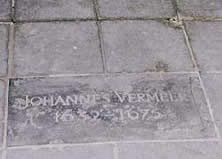
The historical records of the venerable Old Church in Delft confirm Vermeer's burial on December 15, 1675. The once prosperous painter left behind 11 minor children and substantial debts for his wife, Catharina. Seeking relief from her creditors, she bemoaned the financial strain resulting from her husband's decline into "decay and decadence," transitioning swiftly "from being healthy to being dead" in a single day. The term "decadence" could imply that the artist had succumbed to drink, a prevalent issue in the Netherlands, or more plausibly, a sudden physical deterioration due to a stroke or heart failure. While two tomb markers indicate Vermeer's interment in the Delft Old Church, the precise resting place of the artist's remains has been forever lost.
We still lack information about Vermeer's artistic training, his character and even his physical appearance due to the absence of self-portraits. However, a recent discovery in the Delft Heritage City Archives sheds a differnt light on a posthumous events of the painter.

Funeral Procession of William Lodewijk Count of Nassau, July 13, 1620 in Leeuwarden
Pieter Feddes van Harlingen
ca. 1620
Publisher: Claes Jansz. Visscher
Published in: Amsterdam
Etching; frieze of four sheets joined and bound in a modern vellum and paper binding, 54.6 x 41.7 x 8 cm.
Metropolitan Museum of Art, New York
In preparation for an exhibition on Vermeer's life at the Museum Prinsenhof Delft, Bas van der Wulp, a city archives member, unearthed an unknown mention of Vermeer in a burial register at the Old Church. According to the register, the painter's coffin was carried by a remarkable fourteen pallbearers, accompanied by one ringing of bells. This lavish treatment stands out, as Van der Wulp notes, particularly in comparison to other artists in the guild. The son of Vermeer's mother-in-law, Maria Thins, who faced psychological struggles, received the same treatment a year later. It is likely that Maria Thins covered the costs, perhaps unaware of Vermeer's dire financial situation.

